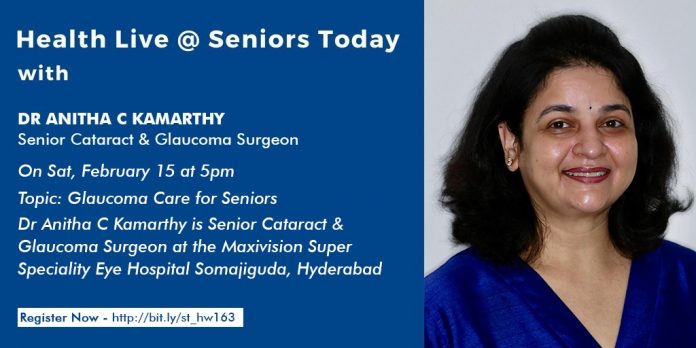On 15 Feb 2025, Seniors Today hosted their weekly Health Live Webinar with a Senior Cataract and Glaucoma Surgeon, Dr Anitha C Kamarthy who spoke on and answered questions about Glaucoma Care for Seniors.
About Dr Anitha C Kamarthy
Dr Anitha C Kamarthy is Senior Cataract & Glaucoma Surgeon at the Maxivision Super Speciality Eye Hospital Somajiguda, Hyderabad
Glaucoma is a group of eye diseases that damage the optic nerve. It is usually because of raised eye pressure.
There are three types of Glaucoma:
- Open angle glaucoma
- Angle closure glaucoma
- Normal tension glaucoma
Glaucoma is one of the leading causes for blindness. And if left untreated, it can lead to visual debilitations.
Risk factors for glaucoma:
- Age > 60 years
- Family history. The risk for developing glaucoma if you have a family history of glaucoma is as high as 30%. If you do not have a family history, the risk is 16%
- Ethnicity- Americans, Africans, Hispanics and Asians are at a higher risk. The only people protected right now are the European population
- Coexisting medical conditions such as diabetes mellitus, hypertension and eye trauma
- History of long term steroid use
Symptoms of glaucoma:
- In the early stages, it is often asymptomatic
- Blurred vision
- Halos around lights
- Loss of peripheral vision. In the early stages, not most people can detect/ understand that they have lost their peripheral vision. Its only in the later stages, when they have lost a significant amount of their vision, do they realise that they might have glaucoma.
Diagnosing glaucoma is very important. Detecting it early will mean that the treatment has started early on and help save loss of vision.
For early detection and diagnosis, it is important that you get regular eye examination by an ophthalmologist and not by an optometrist.
Common tests that are performed are:
- Tonometry is done to measure the pressure in your eye
- Fundoscopy to know how the nerve is
- Visual field tests and glaucoma optical coherence tomography are done if we suspect an abnormality during the fundoscopy
Treatment modalities include:
- Initially the patient is started on medications, usually the eye drops. They work wonders, they lower the eye pressure if they patient is strictly compliant and adherent to the medication
- Oral medications are given only when the pressures are very high
- Laser treatment includes:
-
- Peripheral iridotomy
- Laser trabeculoplasty
- Laser transscleral photocoagulation
These are less invasive. They do work well, however the end result varies from patient to patient
- Surgeries include
-
- Microablation glaucoma surgeries
- Trabeculectomy
- Tube procedures
The challenge with treatment is adherence to the treatment
You can set alarms, reminders or set it in your calendar to help you remember to take your medication
You can also have your family members help you take your medicine on time.



